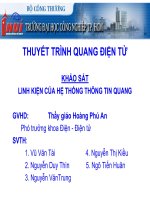PROTEIN SYNTHESIS (thuyết trình)
Bạn đang xem bản rút gọn của tài liệu. Xem và tải ngay bản đầy đủ của tài liệu tại đây (927.16 KB, 55 trang )
PROTEIN
SYNTHESIS
Protein synthesis
Aspects of protein synthesis
Mechanism of protein
synthesis (Prokaryotic)
Initiation in eukaryotes
Translational control and posttranslational events
Q1: Aspects of
protein synthesis
Codon-anticodon interaction
Wobble
Ribosome binding site
Polysomes
Initiators tRNA
Codon-anticodon
interaction
In the cleft of
the ribosome, an
anti-parallel
formation of three
base pairs occurs
between the codon
on the mRNA and
the anticodon on
the tRNA.
Some highly purified tRNA
molecules were found to interact with
more than one codon, and this ability is
correlated with the presence of
modified nucleosides in the 5’anticodon position, particularly inosine
(formed by post-transcriptional
processing of adenosine by anticodon
deaminase)
Wobble
To explain the redundancy of the
genetic code. 18 aa are encoded
by more than one triplet codons
which usually differ at 5’anticodin base
5'-anticodon base
is able to undergo
more movement than
the other two bases
and can thus form
non-standard base
pairs as long as the
distances between the
ribose units are close
to normal.
All possible base pairings at the
wobble position
No purine-purine or pyrimidine-pyrimidine
base pairs are allowed as ribose distances
would be incorrect (Neat!).
U is not found as 5’-anticodon base
Wobble pairing: non Wastoncrick base paring
Ribosome binding site
(Shine-Dalgarno sequence)
Solely for prokaryotic translation
A purine-rich sequence usually
containing all or part of the sequence
5'-AGGAGGU-3'
Upstream of the initiation codon in
prokaryotic mRNA
To position the ribosome for
initiation of protein synthesis
Shine-Delgarno element
Polysomes
Each mRNA transcript is read
simultaneously by more than one ribosome.
A second, third, fourth, etc. ribosome starts
to read the mRNA transcript before the first
ribosome has completed the synthesis of
one polypeptide chain.
Multiple ribosomes on a single mRNA
transcript are called polyribosomes or
polysomes.
Multiple ribosomes can not be positioned
closer than 80 nt.
Polysomes
Electron micrographs of ribosomes
actively engaged in protein synthesis
revealed by "beads on a string"
appearance.
Initiator tRNA
Methionine is the first amino acids
incorporated into a protein chain in
both prokaryotes (modified to Nformylmethionine) and eukaryotes.
Initiator tRNAs are special tRNAs
recognizing the AUG (GUG) start
codons in prokaryotes and
eukaryotes.
Initiator tRNAs differ from the one
that inserts internal Met residues.
Initiator tRNA, fMet-tRNAfMet in E. coli
Lacking alkylated A endorses more
flexibility in recognition in base pairing (both AUG and GUG).
Initiator tRNA formation in E. coli
1. Both initiator tRNA and noninitiator tRNAmet
are charged with Met by the same methionyltRNA synthetase to give the methionyl-tRNA
2. Only the initiator methionyl-tRNA is modified
by transformylase to give N-formylmethionyltRNAfmet.
Q2: Mechanism of protein
synthesis (Prokaryote)
Protein synthesis falls into three
stages .
1.initiation-the assembly of a
ribosome on an mRNA molecule.
2.elongation-repeated cycles of
amino acid addition.
3.termination-the release of the new
protein chain.
Initiation
In prokaryotes, initiation
requires
the large and small ribosome
subunits,
the mRNA
the initiator tRNA
three initiation factors .
Size comparisons show that the ribosome
is large enough to bind tRNAs and mRNA.
IF1 and IF3 bind to a
free 30S subunits.
IF2 complexed with GTP
then bind to the small
subunits, forming a
complex at RBS.
30S initiation complex
The initiator tRNA can
then bind to the complex
at the P site paired with
AUG codon.
The 50S subunits can now
bind. GTP is then
hydrolyzed and IFs are
released to give the 70S
initiation complex
The assembled
ribosome has two
tRNA-binding sites,
which are called Aand P-site, for
aminoacyl and peptidyl
sites respectively.
Only fMet-tRNAfMet can
be used for initiation
by 30S subunits; all
other aminoacyl-tRNAs
are used for
elongation by 70S
ribosomes.
Elongation
With the formation of the 70S
initiation complex, the elongation
cycle can begin.
Elongation involves the three
factors, EF-Tu, EF-Ts, EF-G, as well
as GTP, charged tRNA and the 70S
initiation complex.
The three steps of elongation
1.Charged tRNA is delivered as a complex
with EF-Tu and GTP .
2.Peptidyl tranferase (50S ribosomal subunit)
makes a peptide bond by joining the two
adjacent amino acid without the input of
more energy.
3.Translocase (EF-G), with the energy from
GTP, moves the ribosome one codon along
the mRNA, ejecting the uncharged tRNA
and transferred the ribosome peptide from
the mRNA.
EF-Tu-Ts exchange cycle
Peptide bond
formation takes
place by reaction
between the
polypeptide of
peptidyl-tRNA in
the P site and the
amino acid of
aminoacyl-tRNA
in the A site.









